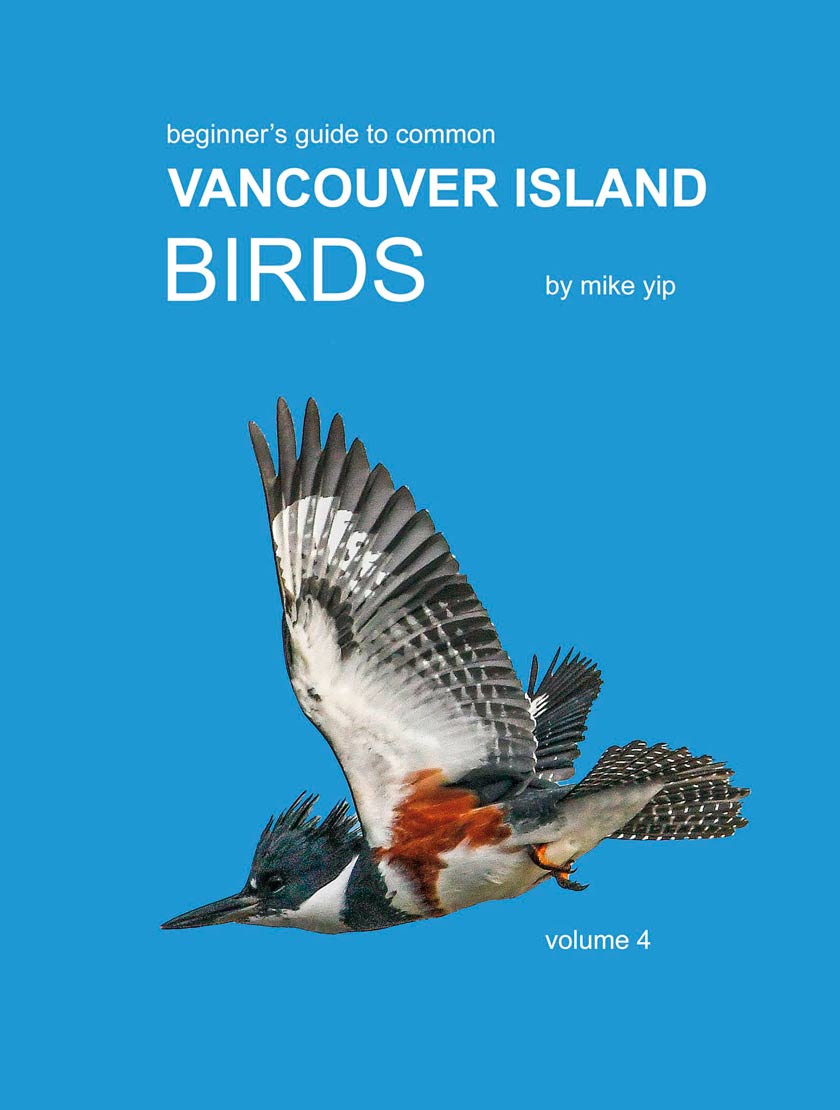
2020 - It was a good year for enjoying the birds and nature, and I was pleased with many of my photographic efforts. No, I didn't achieve it by setting the bar too low. For some reason I was more focused even before the COVID 19 restrictions. COVID 19 did stop me from marketing my new book from April to August, and that freed up a lot of time for photography, but otherwise it didn't affect me too much. My three birding highlights of the year were the exquisite male Mandarin Duck, midshipman madness with the Bald Eagles, and discovering the first ever female Common Pochard in BC and Canada. The pochard discovery was on December 23 which made it a timely and wonderful Christmas present. Unfortunately, it was flushed by a Bald Eagle and was only enjoyed by a few others. The photo above shows the last few seconds of the pochard as it headed for parts unknown.
RANDOM SHOTS
I still had a few shots from 2020 that are worth sharing so here they are. I hope you can enjoy them and maybe find something educational.

The Great Blue Heron is one of our most cooperative and photogenic birds. It often is tolerant of photographers in close proximity especially if it is focused on a potential snack. It's always a challenge to capture an image out of the normal array of hunting and flight shots, and that was my challenge at the Courtenay Airpark. Since the heron wasn't having much luck it decided to find a new location which gave me the opportunity to photograph it in stride. I have hundreds of Great Blue Heron images, but this was the first in this pose, and I like it. Beauty is in the eyes of the beholder.

I am sometimes so focused on finding less common birds that I neglect the more common species. Esquimalt Lagoon is a terrific location for Red-winged Blackbirds, and I generally ignore them. Instead of looking for the usual species in the lagoon I actually spent some time with the Red-wingeds first and enjoyed my session with them. The Red-wingeds seemed to be partial to the Nootka Rose where they were feasting on rose hips. They must know that the rose hips are loaded with vitamins and other healthy nutri,ents.

I am mainly a fair weather photographer, but during our wet, west coast winters fair weather can be a scarce commodity. As a result, a cloudy day with no rain is occasionally an invitation to venture out. A close-up of a Green-winged Teal would have been much more attractive with the sun enhancing the colours but that didn't detract form the joy of being out and seeing some birds. It was interesting that the Green-winged Teals preferred foraging on the near side of the pond hidden beside the tall grass and riparian weeds. That meant I had to be ready once they flushed. Most of the times they flew out, but the occasional one would casually swim out trusting that I only wanted to take a picture.

Gunnel fish à la carte being enjoyed by a female Common Merganser. Notice the serrated bill. The gunnel fish seems to be abundant and one of the most common meals for diving ducks and other close-to-shore seabirds.

This more like it - a calm, sunny day. After a quick breakfast I grabbed my gear and headed for Deep Bay hoping for a Long-tailed Duck day. I was slightly disappointed to see only one unccoperative Long-tailed in the distance, but thankfully there were a few other species around like the male Common Merganser. It is always a photo challenge to photograph targets with extreme contrasting colours. Over the years I've found that an exposure compensation of -0.7 is quite satisfactory.

You can only dream of a sunny day, flat water, and a full frame target. The female Bufflehead is one of the more obliging ducks I've experienced, and she proved me right by foraging casually close to shore.

As I was leaving Deep Bay a trio of Trumpeters flew in and landed. I've always enjoyed seeing and photographing the Trumpeters, and this was a perfect opportunity and situation - on the water, close in with the sun at my back. The trio also presented the opportunity for some group shots which was a real challenge with the big lens. Look closely at the bill of the middle swan. Notice anything unusual?

The middle swan had yellow spots on the side of its bill. Originally David Sibley wrote that the Trumpeter never has yellow on its bill, but observations by swan experts detected the occasional Trumpeter with yellow spots. Sibley has since accepted the fact that it is possible with the explantion that it could be a vestigial remain from the evolution of the species. Hybridization with Tundras has been ruled out and so has leucism.
AN IRRUPTION YEAR
Anyone who has been birding anywhere in Canada will tell you that this has been a year for irruptions. Apparently, it has been a poor year for seed crops in the boreal forest so huge flocks birds like Pine Siskins and Pine Grosbeaks have invaded southern Canada which has an abundant seed crop this year. The abundance of seed crops is cyclical and the massive amount of pollen drifting from the conifers this spring was sign that this was our year. On the island the Pine Siskin flocks have been huge and there have been more White-winged Crossbills than usual. I'd love to trade some of our siskins for the grosbeaks and redpolls they been having in the east, but so far no takers.

I've been seeing large flocks of siskins all fall and so has my friend, Barry Kerr, who was impressed by the many murmurations around his home. However, the most remarkable scene was on the morning of December 1 after a night of treacherous and violent winds that crippled the power grid and damaged many properties and homes with trees ripped from the ground. The wind had subsided and the sun was shining when I pulled open the curtains that morning. I couldn't believe my eyes to see my yard covered from one end to the other with Pine Siskins rapidly foraging on the ground. As far as I could ascertain the storm had dislodged bushels of seeds from the surrounding conifers leaving a delicious breakfast banquet for the birds. The was easily over a thousand birds.

I didn't hesitate to grab my camera to look for some photo opportunities. A flurry of activity and amazing spray of water from a puddle caught my eye. There was a solid mass of siskins enjoying a morning bath.

The excitement last for another half hour until someone gave the magic signal and they all rose in a huge cloud and disappeared over the forest.

Whenever I got the chance I would scan the flocks of siskins for a redpoll, but so far I've been skunked.

I checked the puddle every day for more bathing siskins, but all I've seen have been a few Varied Thrush and juncos.
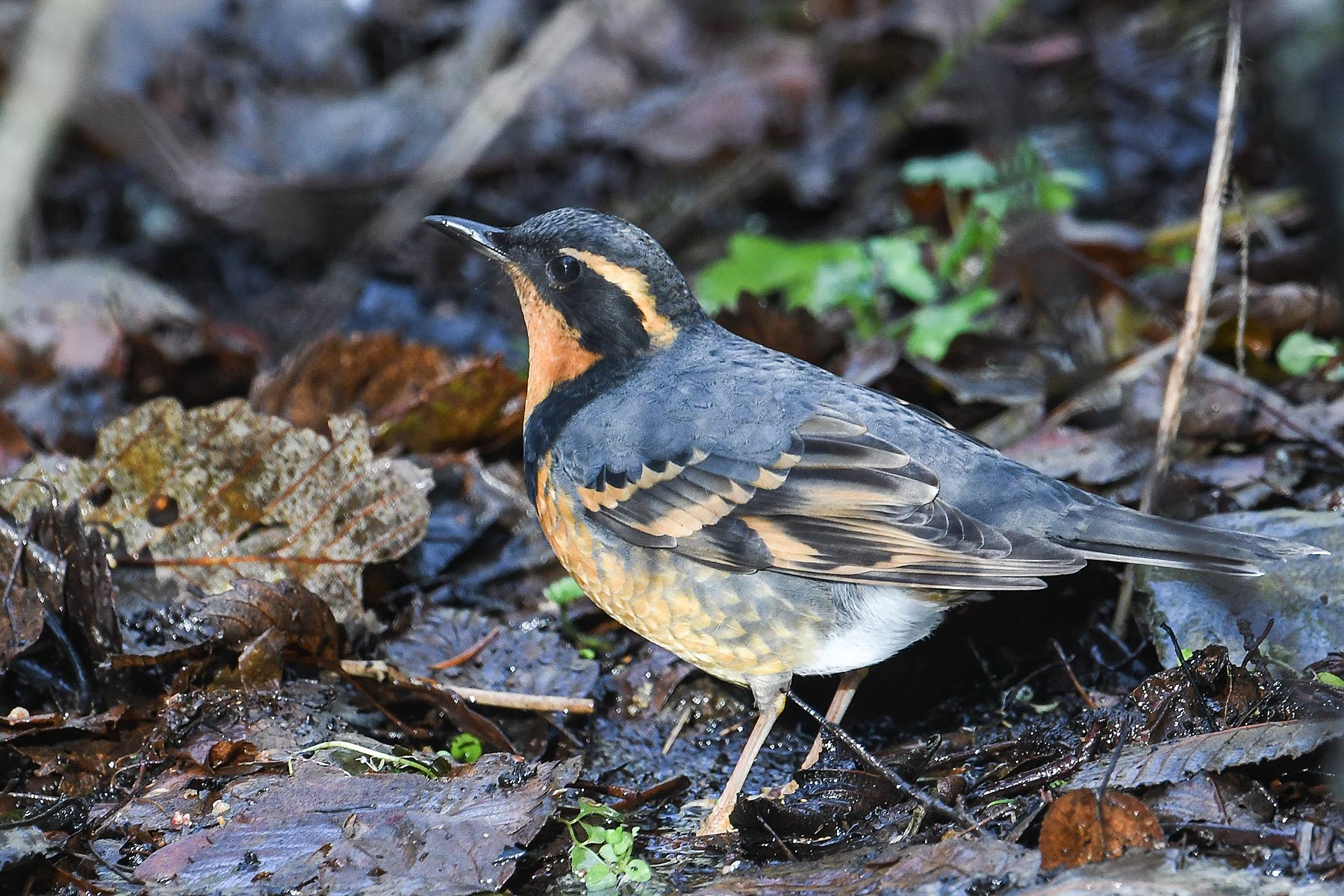
Varied Thrush are a treat to see any time and they have been common all fall in my yard. They mostly forage under the cover of the forest, but I have also seen them checking out the feeders.The darker one in this photo is a male. The previous photo is a female.
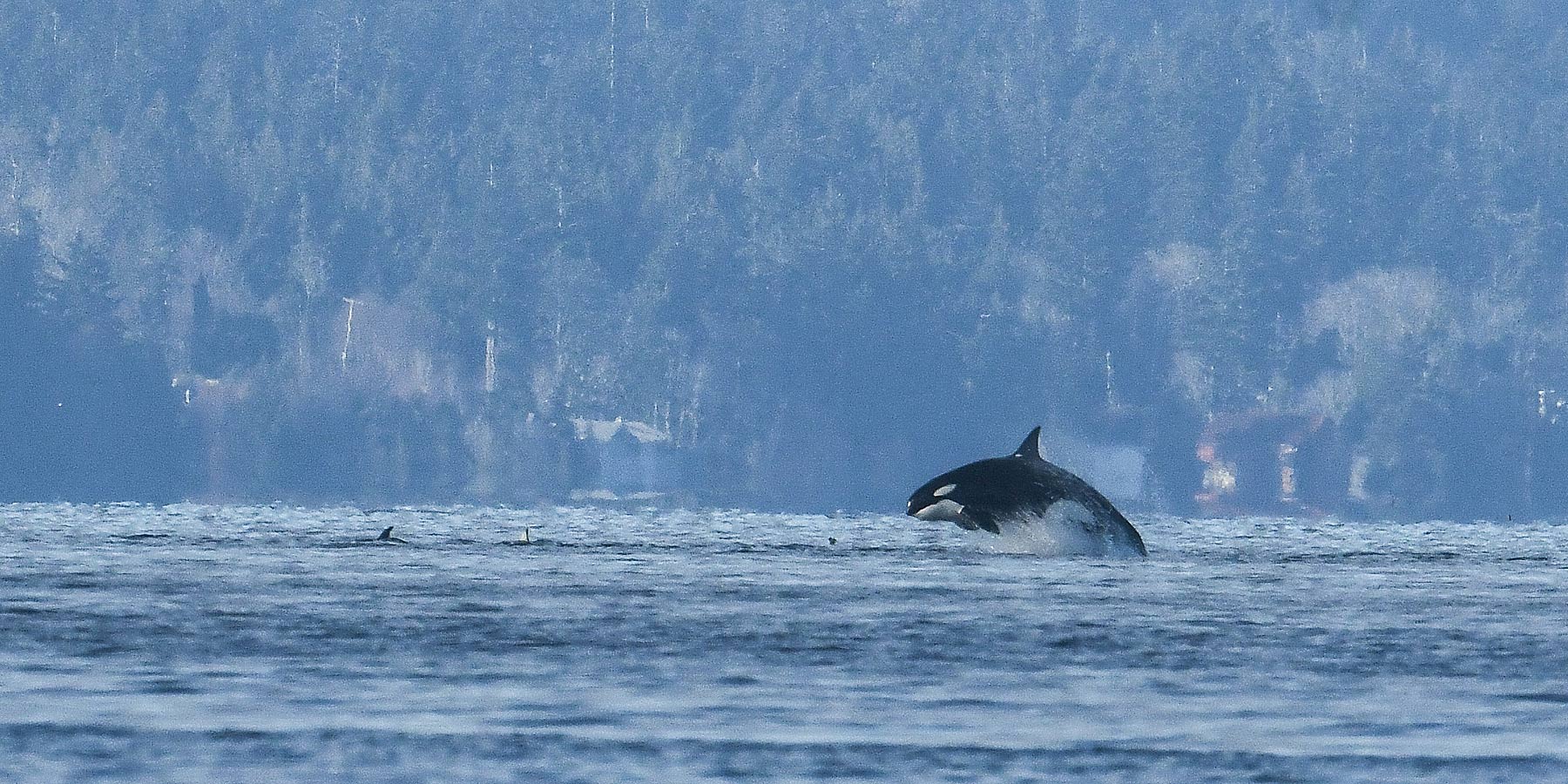
If it flies, it's not always a bird or insect. I would guess that the pod of orcas was almost a kilometer away when i took this shot.
CRAIG BAY
Before Craig Bay was developed it was one of my favorite birding locations. Now its condo city, but several ponds still exist and they are usually populated by ducks and other aquatic loving birds like herons and grebes. I still visit occasionally, and it is one of my favorite locations for Hooded Mergansers.
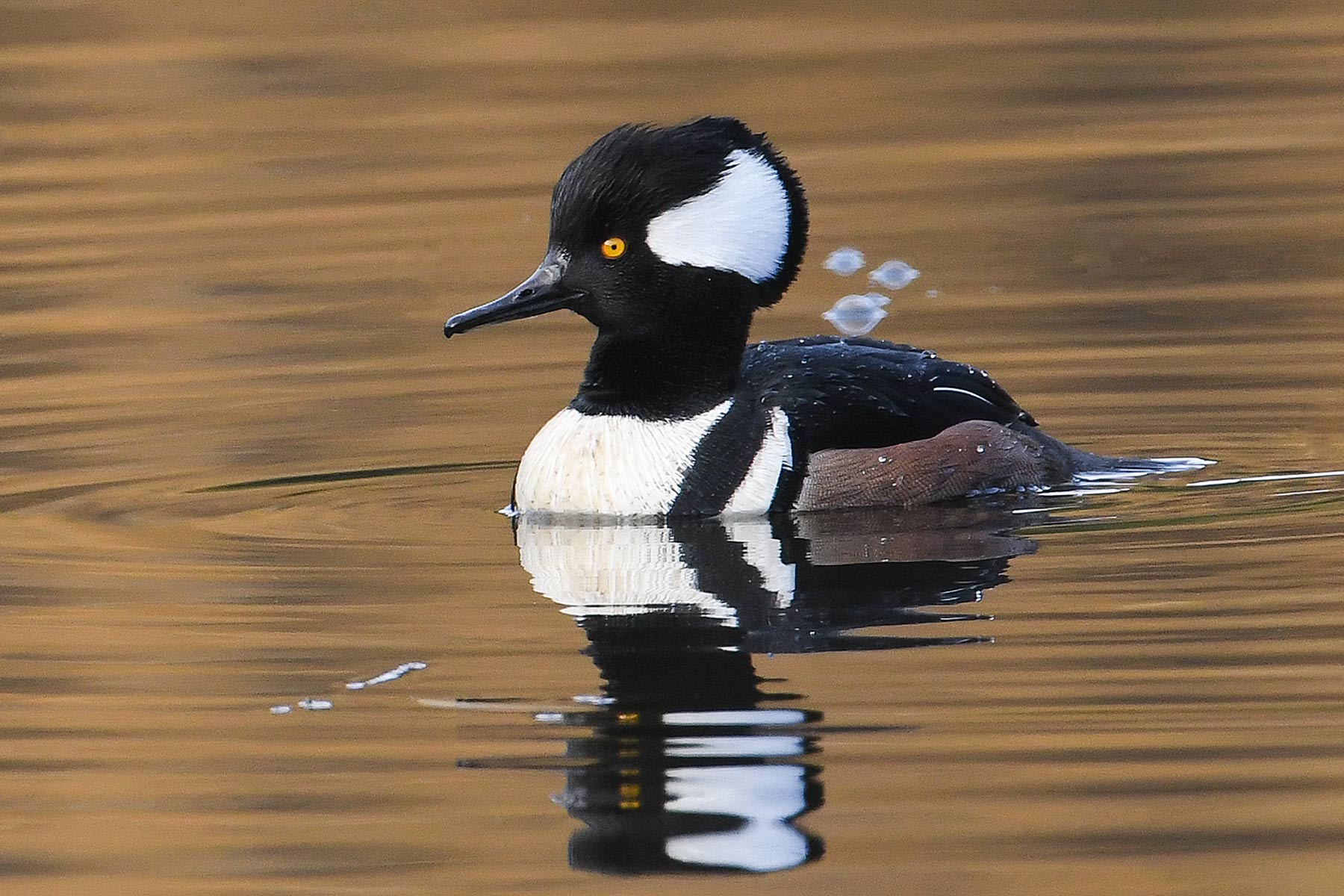
The male Hooded Merganser is considered by some as one of the most beautiful ducks in the world. It's one of my favorites so I won't disagee. On Dec. 9 I stopped by Craig Bay on my way home and was happy to spot a pair of Hoodies by the bridge. The female was foraging in the shaows but the male was in the sun. I can never pass on a chance for a Hoodie so I managed a few clicks before Carol-Ann and Bob walked by.

At the other end of the development I spotted Tony and Jim concentrating on some critters inthe second pond. Curiosity killed the cat, but i was game to check out what was happening. Tony and Jim were focused on the Hooded Mergansers but I was more interested in the lone American Coot because they aren't too common north of Buttertubs Marsh.

A female American Wigeon swam close it the reflection of the bulrush reeds complementing the colours of the duck. I thought it would make a pleasing image. Do you like it?

A pied-billed Grebe was the fourth species in the pond. I always enjoy seeing them and when It eventually worked its way close to use it gave me the chance for a couple of full-frame shots. Just as you would expect for December it was a non-breeding adult.
It was fun to catch up with Tony and Jim to see what they were using. I think Tony had a 4/3 Olympus and Jim had a Sony A9. My Nikon D500 DSLR looked like a dinosaur compared to their lightweight gear.
SERENDIPITY
Dec. 5 - Part of the fun of birding is you never know what or who you will encounter. On this particular day I had to deliver some books to Campbell River and on the way I stopped at Kye Bay to look for the Marbled Godwit that had been seen there a few days earlier. As I expected, the godwit was long gone. To tell you the truth, my next step was to look for a wash room, and I thought there was one along the beach at Point Holmes. Thankfully, I was right and my problem was solved. On emerging from the portapotty I spotted a string of Brewer's Blackbirds along the hydro lines. Right away I thought there might be a Rusty Blackbird in the mix.

I grabbed my camera and was walking towards the birds when I heard a voice, "It's the seventh one to the right of the pole." I looked at the source of the voice and spotted John and Sheri who I had met three weeks earlier at Deep Bay. We exchanged greetings and then I focused on the bird. It wasn't a Rusty. Even better, it was a Yellow-headed Blackbird, my first for the island.

I'm not sure if was a first winter male or a female, but it was a joy to see, and as the photos show it flew down and foraged close to us. The unexpected meeting with John and Sheri and the surprise meeting with the Yellow-headed - that's serendipity. John did his best to sell one of my books but he diddn't earn a commission this time.
It's a bird, it's a plane, no it's a Red-breasted Merganser
Did you know the Red-breasted Merganser is one of the fastest birds in the world?

The Red-breasted Merganser looks ungainly for a duck with its elongated torso but that's because it was built for speed.

Like a sprinter launching itself off the blocks the merganser uses the water for its launching pad.

With its powerful wings and aerodynamic shape the merganser clocks in 128 kph - a speed that is illegal on the Island Highway.
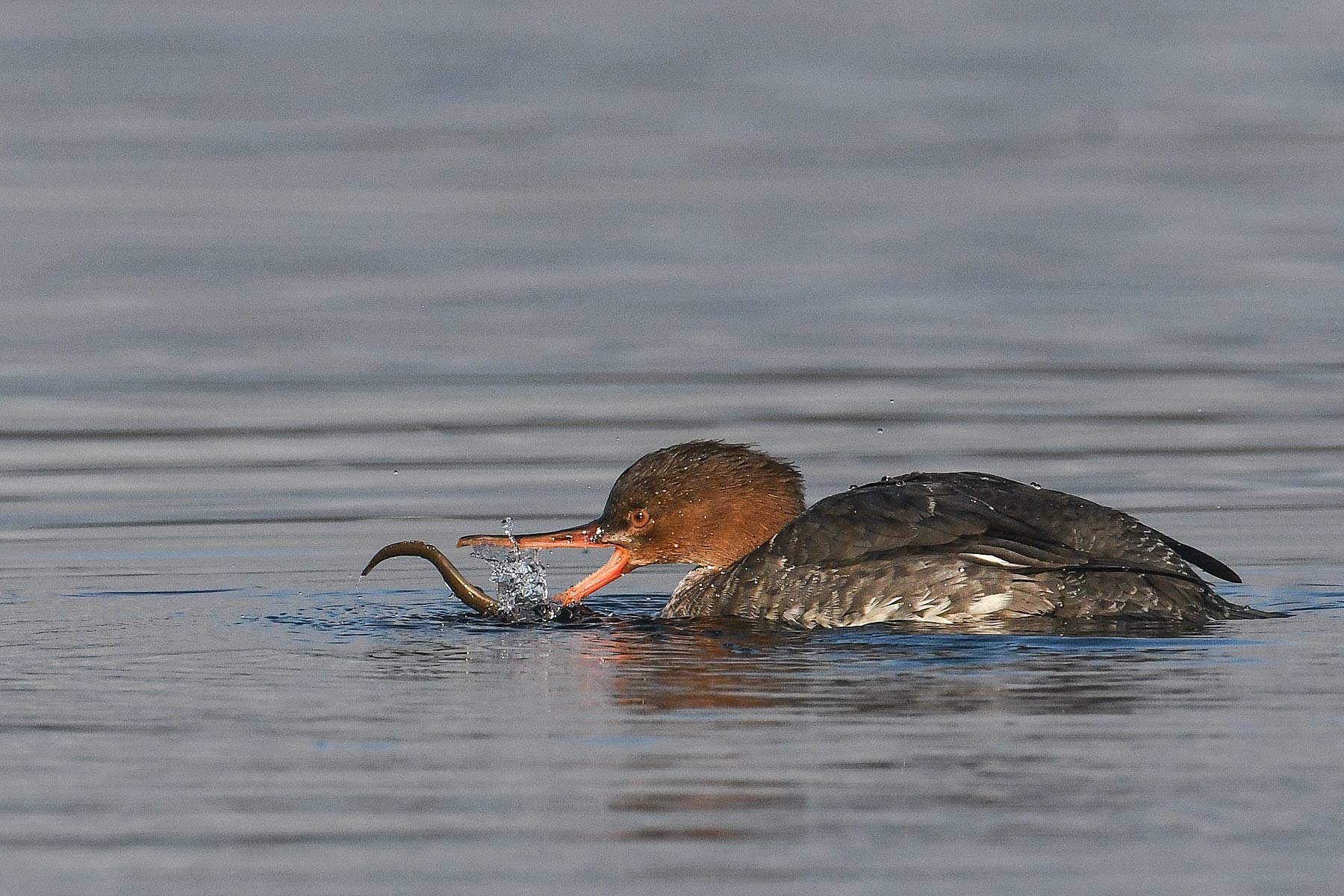
So where does the merganser get all the energy for its powerful flight. Here it is. Turns out that gunnelfish are a superfood. You should try it sometime!

I know I'm getting carried away, but there's probably a lot of truth about the superfood and that applies to all seafood. I actually have recent photos of Glaucous-winged gulls having a gunnel party that I will post some time in the future.
MORE MORNINGSTAR
Morningstar Pond is one of my favorite locations not just for ducks but also for songbirds, turtles, and muskrats.
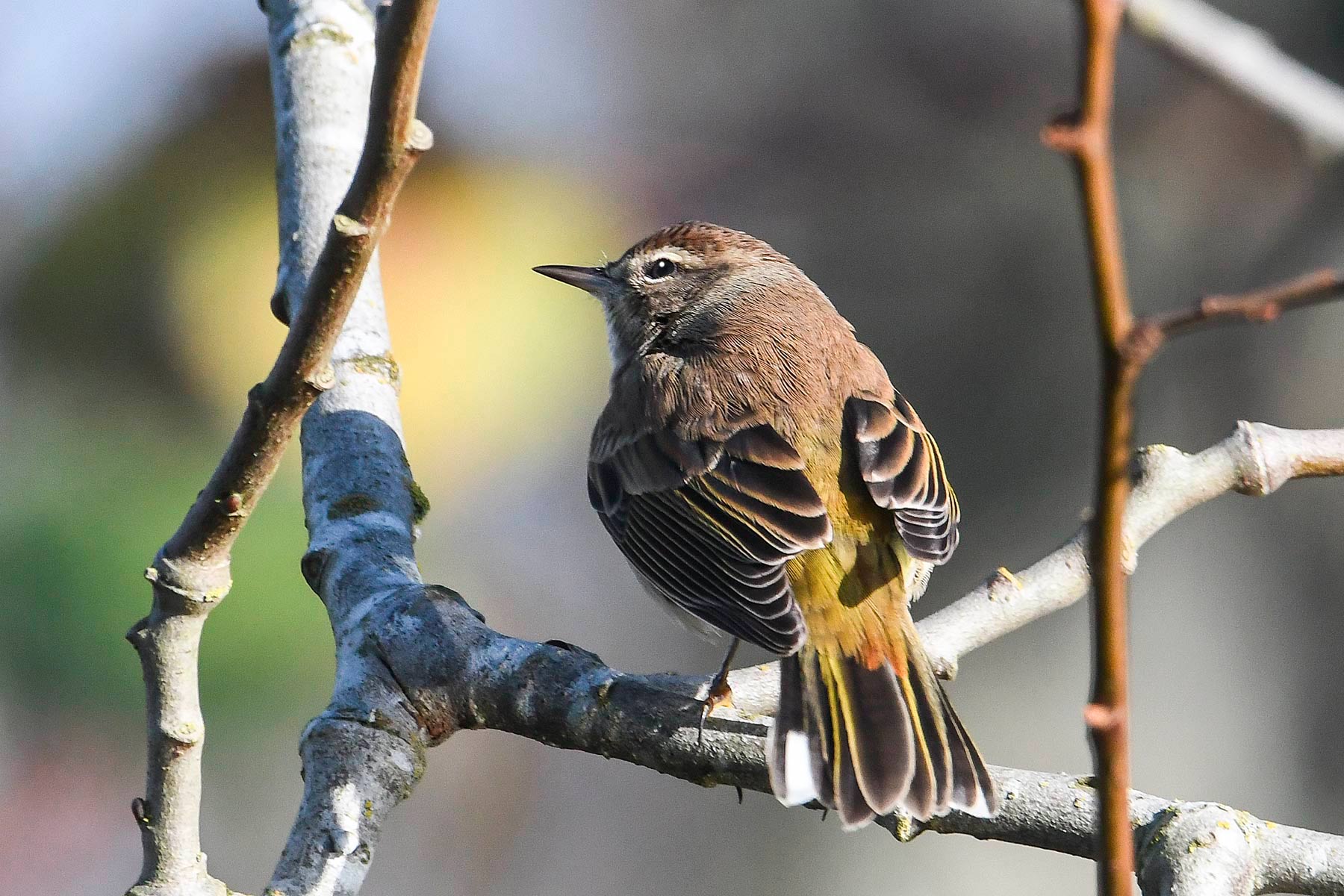
According to John Purves there have been three Palm Warblers this fall and winter. I missed on my first try but I had better luck on December 14.
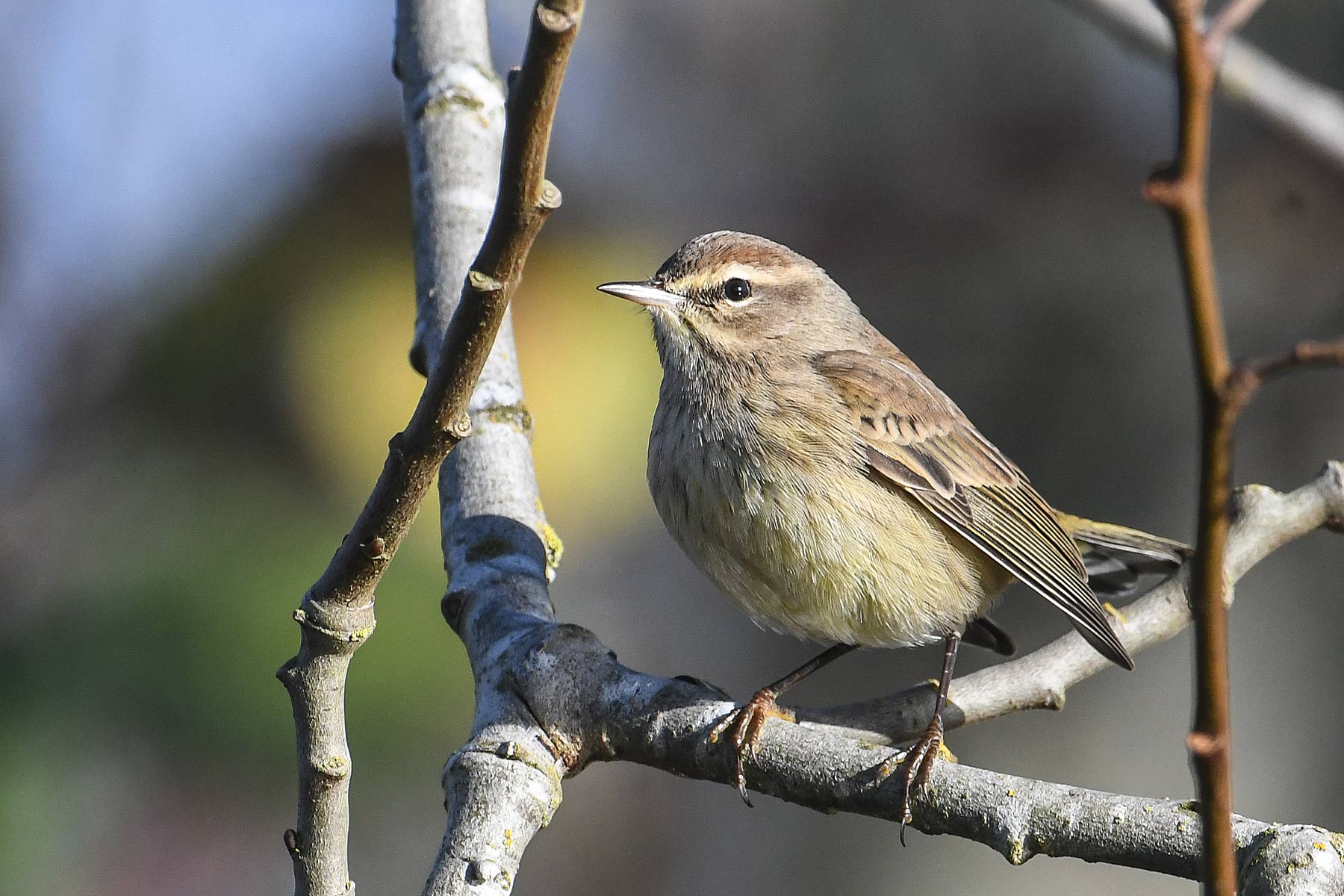
I was checking the trail between the two ponds (just before it was fenced off) when a lone bird caught my attention. It was difficult to get a lear view but the pumping rump told me it was a Palm. The Palm was hawking insects by the pond but eventually flew to the path to forage in the grass. It finally flew to a branch to the right of the path where i got a few shots.

A few seconds later it flew to the other side of the pond where Mark Wynja located it for the benefit of several birders.
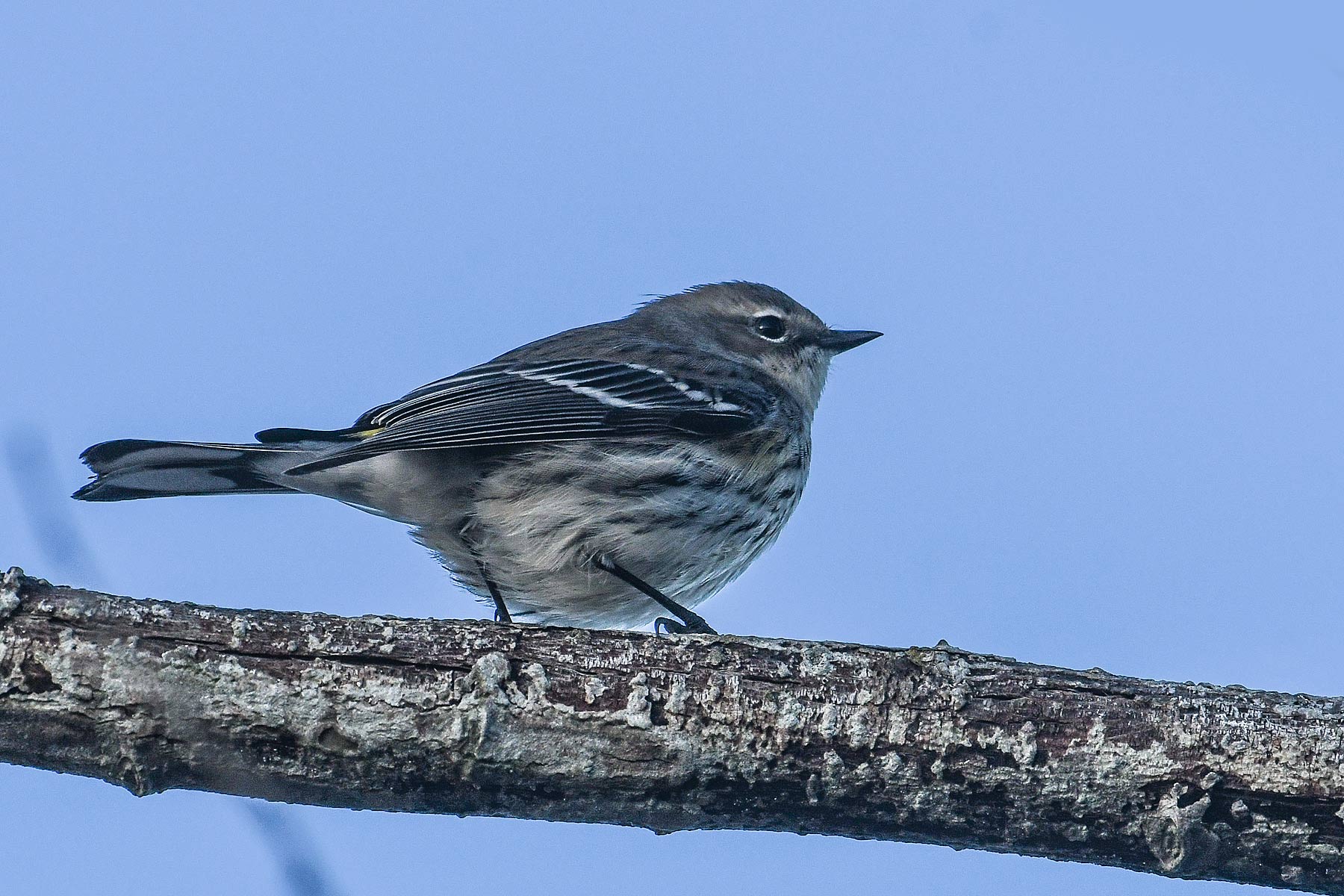
With the Palm Warbler taken care of my focus switched to the Yellow-rumped Warblers. It was December and there were still a lot of Yellow-rumpeds around. In most years they would all be further south down the Pacific coast. Their lingering presence suggests a warmer than usual winter, and so far it has be quite decent.

It's interesting how the light affects the colours as captured by the camera. In the previous shot the bird was in filtered light against the blue sky. In this photo the bird was in the sun on a reed almost at water level.

I don't want to choose between Audubon's and Myrtle subspecies, but I'm leaning towards Myrtle based on pale to whitish throat, throat wrapping around auriculars, and dark auriculars under pale supercilium. What do you think?

On Dec. 25 (nice way to spend Christmas) we checked Morningstar on a misty day and were suprised to see the Yellow-rumpeds foraging on or near the water.

Maybe the earlier rain had knocked a few insects onto the water. Anyway, that's where the food was, and it was fun watching the Yellow-rumpeds plucking them from the water.

Other than the Yellow-rumpeds there wasn't anything else of interest to photograph.
PAYING HOMAGE TO MY INSPIRATION BIRD
In case you didn't know, it was the Northern Shoveler duck that ignited my obsession for birding and photography. So it's fitting that I end the year with a few pics of that lovable, long-billed duck.
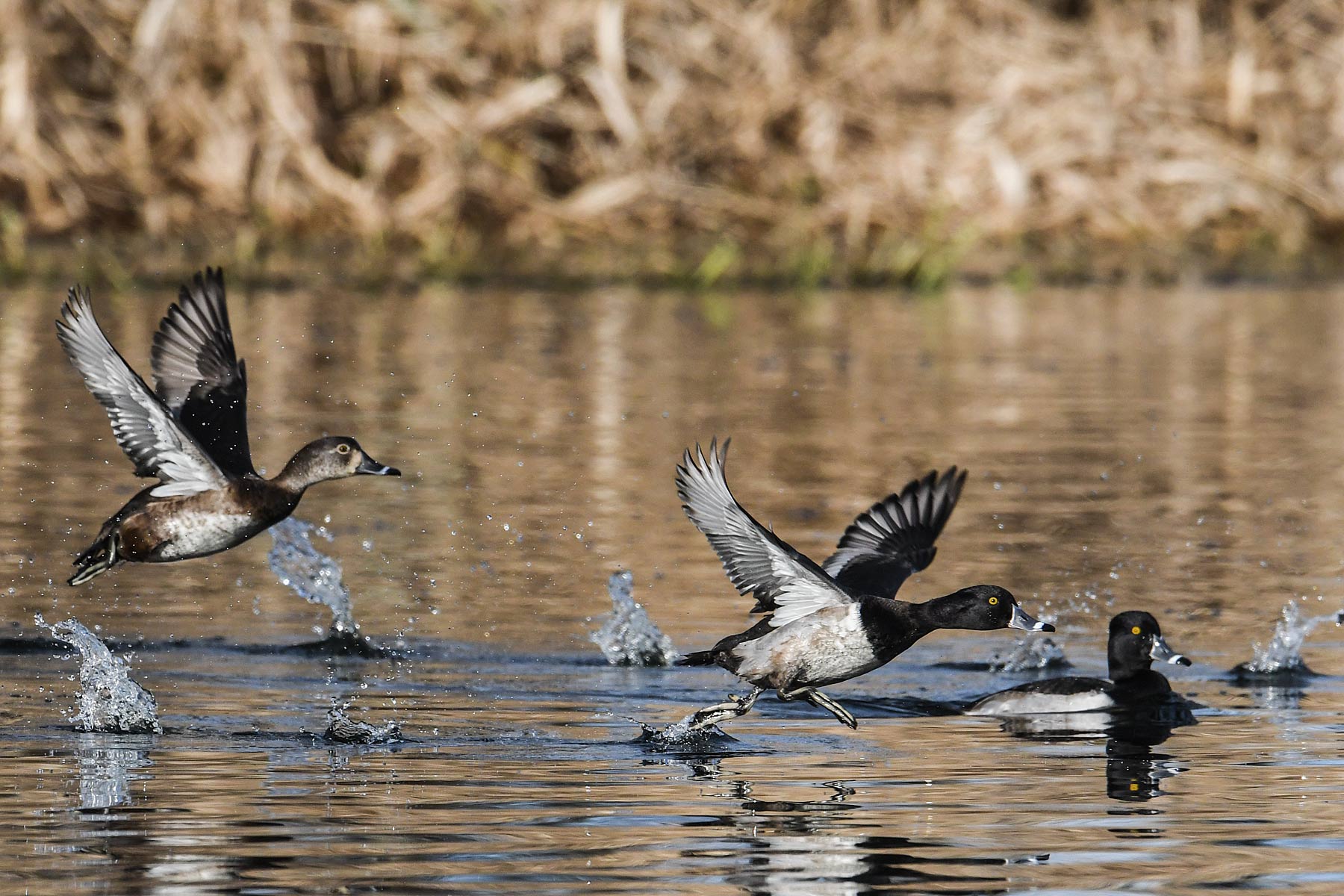
Not so fast. I've got a couple of shots of the Ring-necked ducks to share first. Like the shovelers they are residents at Morningstar.
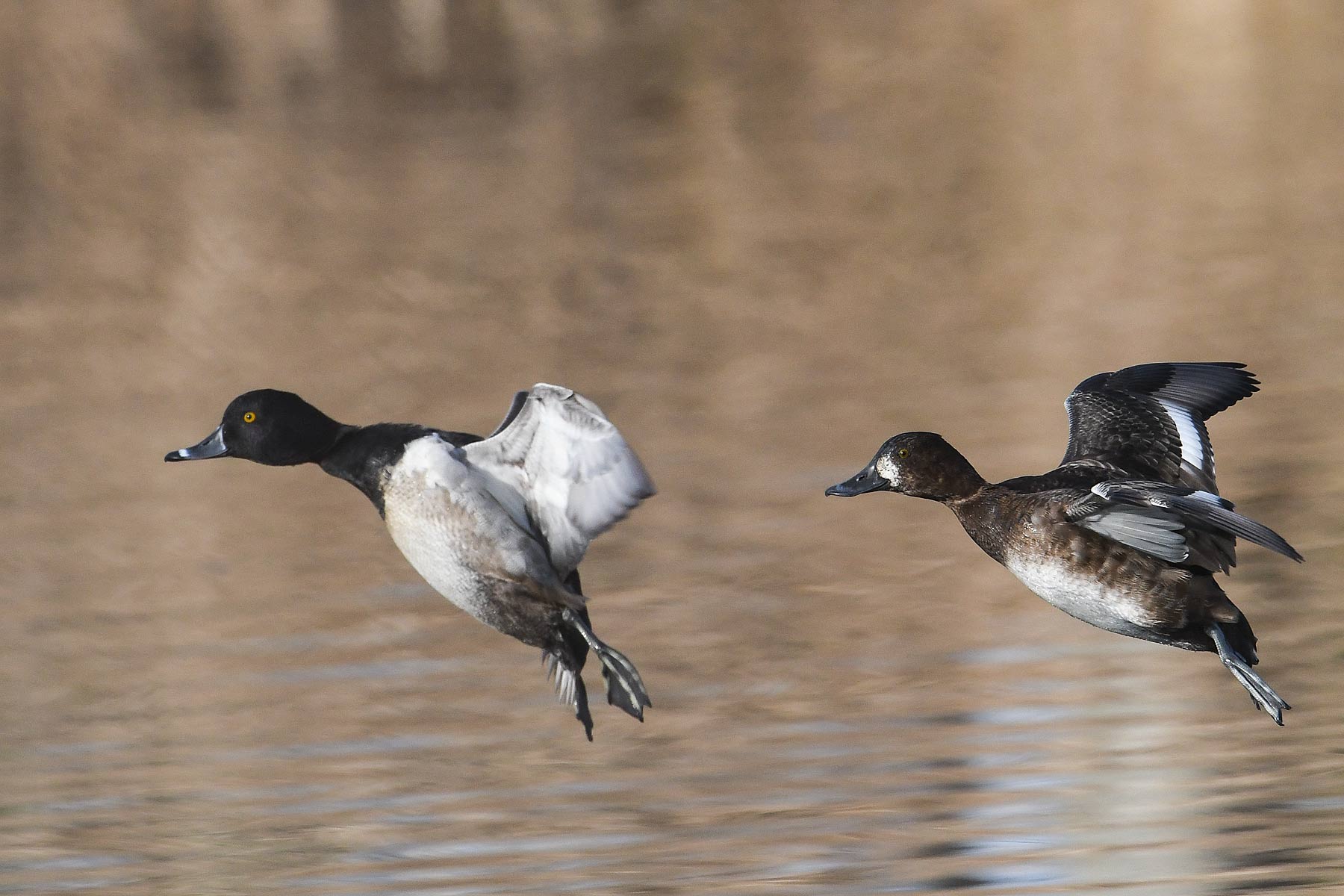
Many beginners ask where the ring is on the Ring-necked. It's there but only visible in good light when the neck is extended. Look closely at the trailing juvenile. A light line can be seen on its neck. The line on the leadin male is barely visible.
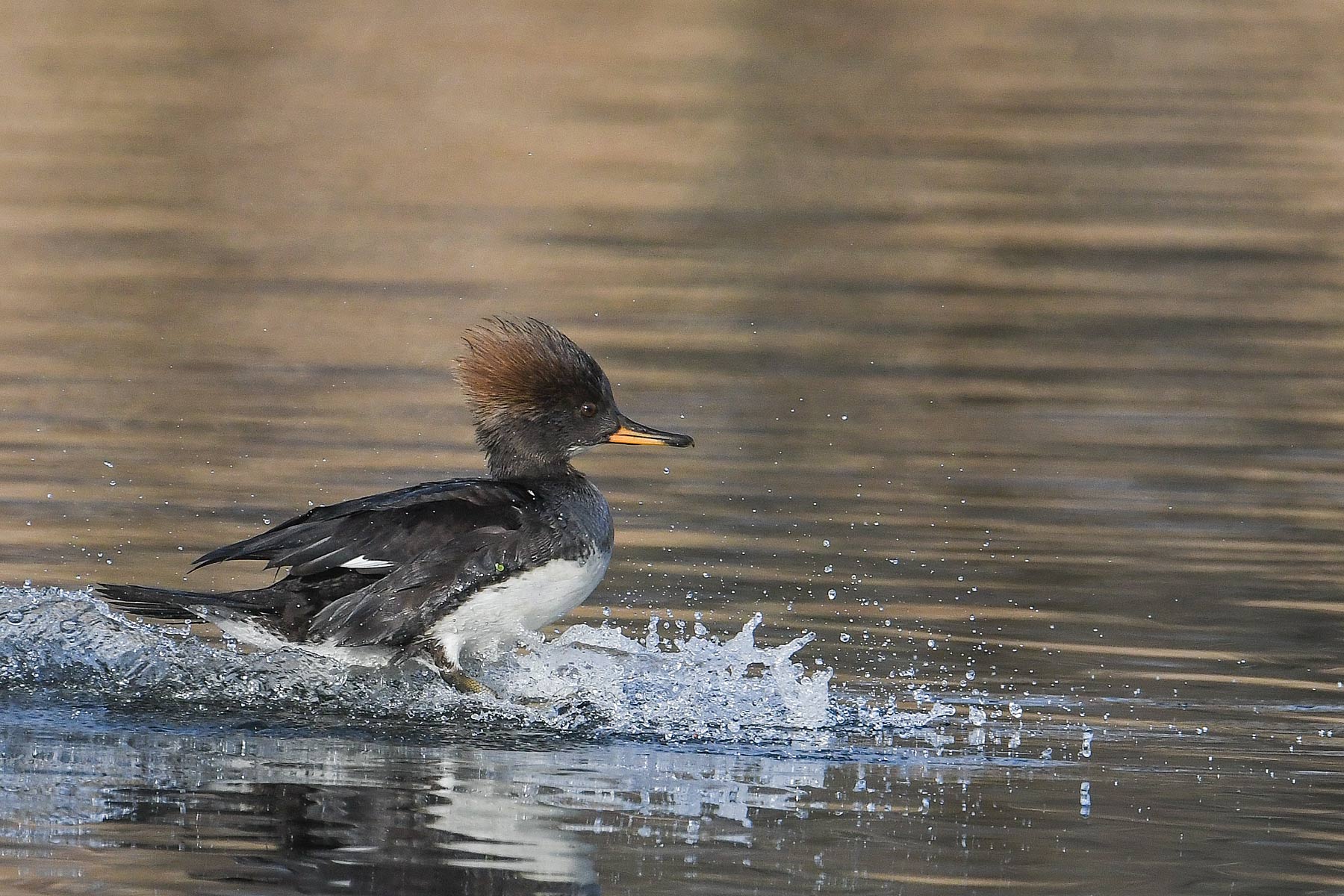
Hooded Mergansers are also common at the pond. Here's a female water skiing.
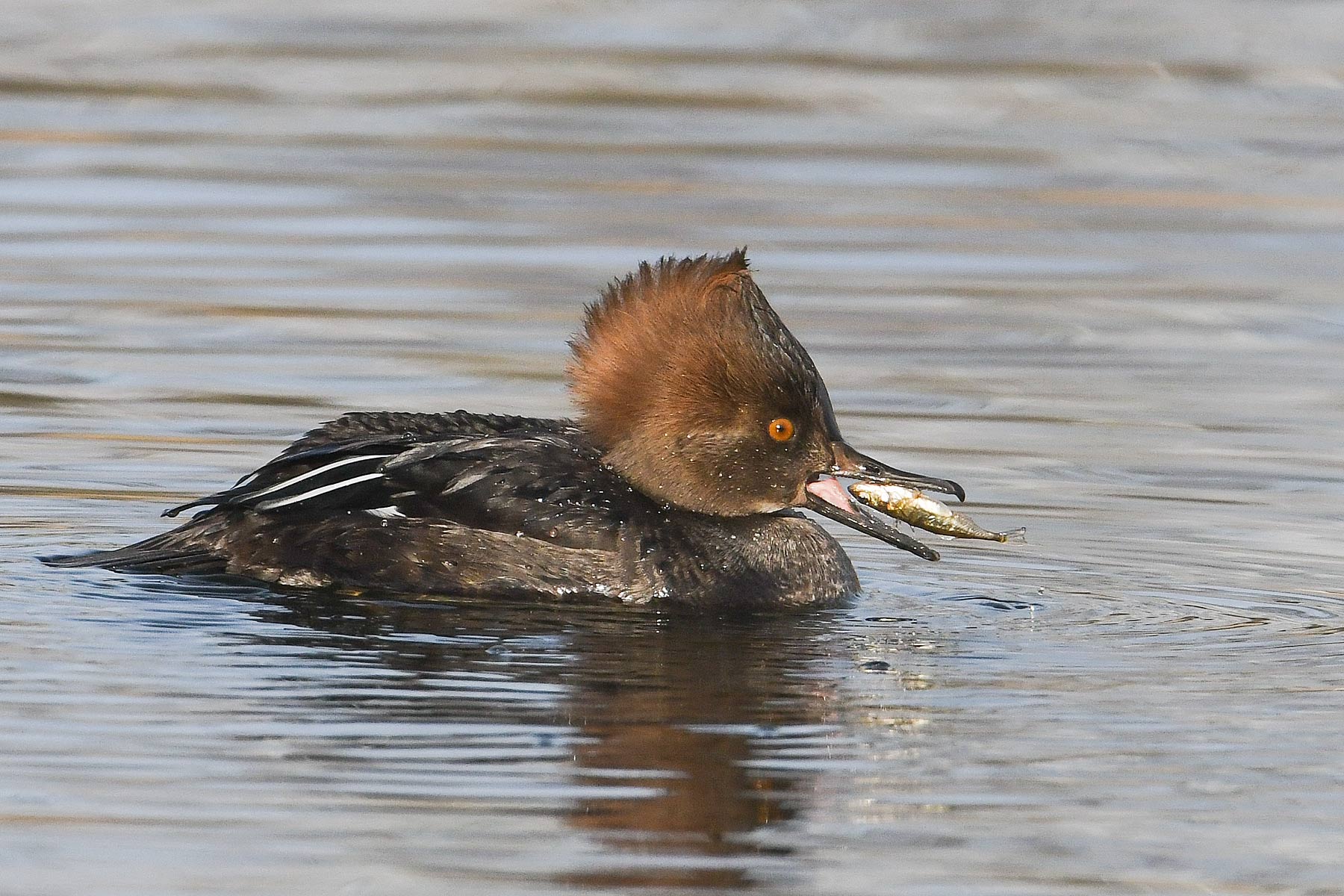
I'm not sure what kind of fish is found in the waste water facility or how they got there, but it's no question asked and a tasty snack for the merganser.

Ok, here comes the shovelers. The blackish tinge on the head suggests they are males.

Shovelers on ice - we've had several nights of sub-zero in the past month. I've only seen the shovelers in the water so it's reassuring to see they have legs and feet.

The dark eyes say this is a juvenile and first winter bird. My guess based on the light colours is that it will be a female.


FAVORITE LOCATION - FRENCH CREEK
Over the years my go to location for photography has bee French Creek. It features three distinctively different habitats that have produced a number fun photo experiences. First there is the creek that changes personality several times a day with the tidal movement as well as several times a year with the seasonal fluctuations of water flow. Second is the marina itself. Although the pollution from the boats have rendered this habitat as unsafe, it is flushed by the tidal changes and provides a protected environment for Common Loons and a variety of ducks. Third, the eastside beach can be productive for gulls and a variety of shorebirds.
Unfortunately, the steady increase in pedestrian traffic and photographers has degraded the experienceover time. At one time it was just me and the birds, but that rarely happens now. However, I'm not totally antisocial, and there are a number of photographers I enjoy networking with. French Creek still presents many good photo opportunites and will still be one of my regular stopping locations. Just to prove my point, here is a sample from Dec. 22.

It was a beautiful, sunny, winter day when I pulled into French Creek, and best of all there were no cars or photographers in sight. I parked in the visitors spot, set up my gear, and headed to the creek. As I neared the creek I noticed the resident House Finches feeding on Pacific crabapples that were entangled in the blackberry thicket. There were several males busily munching on the fruit which provided some interesting photography. The male House Finch is quite an attractive bird, and I couldn't resist some close-ups of them foraging for crabapples.

With the sun at my back this was an excellent opportunity for optimum colour quality.

After the finch shoot I meandered down the creek mouth on the breakwater. That's where I photographed the Pacific Loon in the last journal. It was unusually quiet with only a pair of Buffleheads near the washroom. The male Bufflehead was diving close to the breakwater, and with the sun at my back it was a good photo opportunity. I kept still until it dove again and moved to where I thought it would emerge. I was pleased with the result even though I was looking down at the duck. However, it was impossible to get a sea level shot in that location.

There were sealions sitting on the end of the break water, but I was more interested in a group of Common Goldeneye. They were too far for decent shots, but I waited hoping they would come closer. They didn't but they did fly a short distance and land again. With the good lighting and no heat shimmer to worry about, it provided a few decent flight and landing shots.

With time on my hands I decided to check out the other side of the creek. It was high tide and the creek was loaded with Canada Geese. As I scanned the flock I noticed a ball of white feathers,. Maybe a sleeping gull I thought, but on closer examination it was too white. It had to be a sleeping Snow Goose. Eventually it woke and drifted towards me. I didn't notice at first but there was a gray coloured goose close to it - a juvenile. Snow Geese aren't uncommon, and I had seen several earlier in Courtenay, but this was my first of the year at French Creek. A few western Snow Geese do winter here but most cross the strait to the Fraser delta them winter in Washington. Most of my past shots have been on land so it was refreshing to catch them on water.
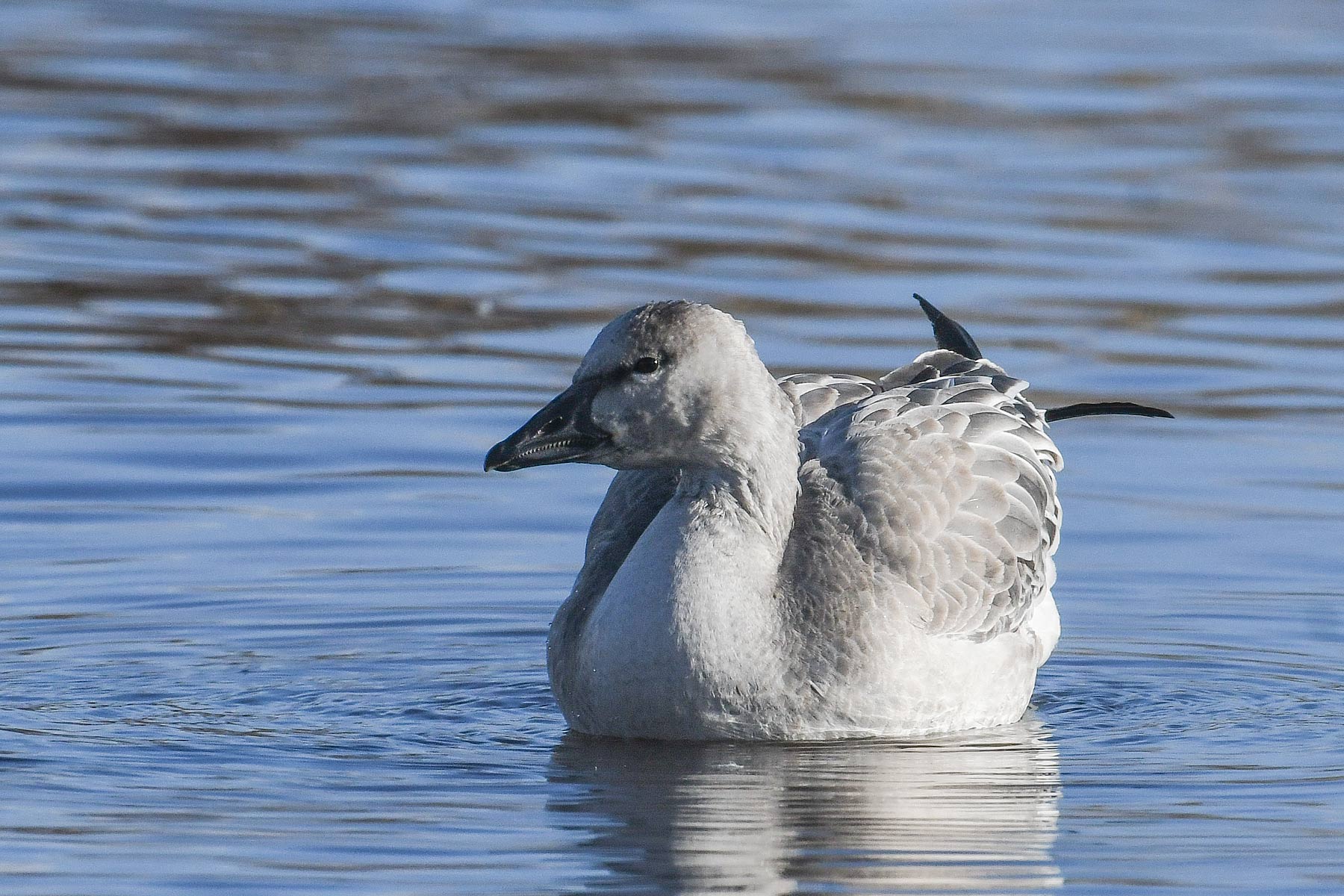
The juvenile Snow Goose was the same size as its parent but quite different with its gray plumage and black bill.

The feature bird at French Creek is the Belted Kingfisher. It's the bird I look for every time I'm there, and it's around about 40% of the time. Many years ago a male kingfisher held title to the area, but for the past 5 years or so it has been the domain of a female. It is one of the most elusive birds to photograph decently on a natural perch. The photos today were on an artificial perch installed on the fence of the drain outlet on the west side of the creek.

The kingfishers are so used to vehicles near the drain outlet that they will perch for extended periods of time when you are parked there. In this case I was shooting the Snow Geese when the female landed. I quickly shifted my focus to the kingfisher and fired a few shots. Suddenly the kingfisher perked up, turned, dove, and gave chase to a male kingfisher. Despite the backlighting my 800 ISO setting gave me a reasonable shutterspeed to catch the action.
So there you have it - a two hour stop at French Creek. House Finches, Buffleheads, Common Goldeneye, Snow Geese, and Belted Kingfisher. Not bad for a two hour stop, and I could have added sealions and Cackling Geese if I wanted. It's not always this busy, but most days there are birds around.
Despite the pandemic it has been a good year for photography, and I have been pleased to share my photos with anyone who is interested. I have a feeling that things will get worse before they get better, but all we can do is continue to be smart - wear masks, physical distance, and be antisocial. I do recommend getting out in nature and doing lots of birding, and that's where I hope to see you. HAPPY NEW YEAR!
*********************************************************************************************

*********************************************************************************************
Bird Poster
My poster is on display at: Victoria - Swan Lake Nature House. (Note: This poster has been produced in a more manageable size and is now available for $20 unlaminated and $32 laminated.)

*********************************************************************************************
PUBLICATIONS
